How to Improve Cold Email Response Rates with Better Data (2025 Guide)
Get Higher Cold Email Response Rates by Building Your Campaign on Verified, Accurate Prospect Data
Blogby JanJune 15, 2025

Cold email response rates have dropped to an average of 1-3% across most industries, while sales teams continue sending thousands of emails monthly hoping for better results. The primary culprit? Poor data quality that leads to generic, irrelevant outreach.
Most sales teams focus on perfecting their email copy, testing subject lines, and optimizing send times. But they're missing the foundation that makes or breaks cold email success: the quality and depth of their prospect data.
After helping 500+ B2B companies improve their cold email results, we've discovered that data quality alone can triple your response rates – without changing a single word of your email copy.
The Data-Response Rate Connection Most Sales Teams Miss
Your cold email response rate tells you one thing: whether your message resonated with the recipient. But here's what most teams don't realize – resonance starts long before you write the first word.
When you have rich, accurate data about your prospects, you're not just sending emails. You're starting conversations with people whose challenges, goals, and current situation you actually understand.
Bad data creates bad targeting. You end up reaching out to people who left the company six months ago, targeting the wrong department, or completely missing the context that would make your message relevant.
Good data creates precise targeting. You reach the right person, at the right company, with the right message, at exactly the right time. The difference? A 1% response rate versus 10%.
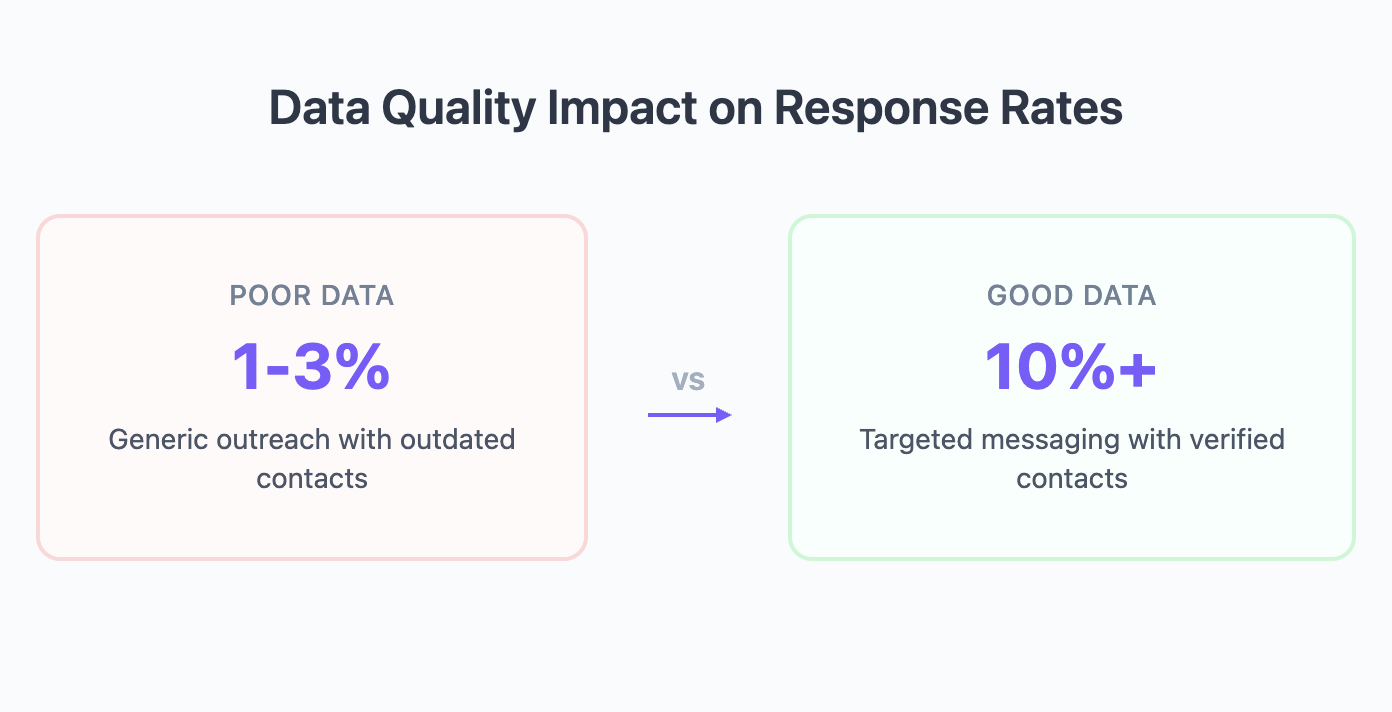
Why Poor Data Quality Kills Your Cold Email Response Rates
Outdated Contact Information
The average B2B contact database degrades by 30% annually. People change jobs, get promoted, or move departments. When your emails bounce or reach the wrong person, you've already lost the game.
But it goes deeper than just email addresses. Outdated data means outdated context. That VP of Sales you're targeting? They might now be the Chief Revenue Officer with completely different priorities.
Missing Context About Your Prospects
Sending "Hey [First Name], I noticed your company [Company Name]" isn't personalization – it's mail merge from 2010.
Real personalization requires real intelligence: What technology stack are they using? What initiatives did they just announce? Who did they just hire? What challenges is their industry facing?
Without this context, your emails feel generic, regardless of how many personalization tokens you use.
Generic Targeting Without Behavioral Insights
Most teams build their prospect lists based on basic firmographics: company size, industry, location. But behavioral data reveals buying intent that static data never could.
A company that just raised funding, posted 10 new engineering jobs, and whose decision-makers are actively engaging with content about your solution category? That's a hot prospect. But you'd never know it from basic firmographic data alone.
5 Types of Data That Move the Needle on Response Rates
Verified Contact Data
This seems obvious, but the execution matters. Verification isn't just about whether an email exists – it's about ensuring you have the most current, direct contact information for your specific target.
Using multiple data sources to verify contacts increases accuracy from 50% to over 80%. That alone can double your response rates by ensuring your carefully crafted messages actually reach their intended recipients.
Technographic Intelligence
Knowing what tools and technologies your prospects currently use transforms your messaging. Technographic data reveals integration opportunities, competitive displacement angles, and specific pain points.
For example, if you're selling a CRM and you know a prospect uses Salesforce but not their marketing automation features, your message can focus on that specific gap.
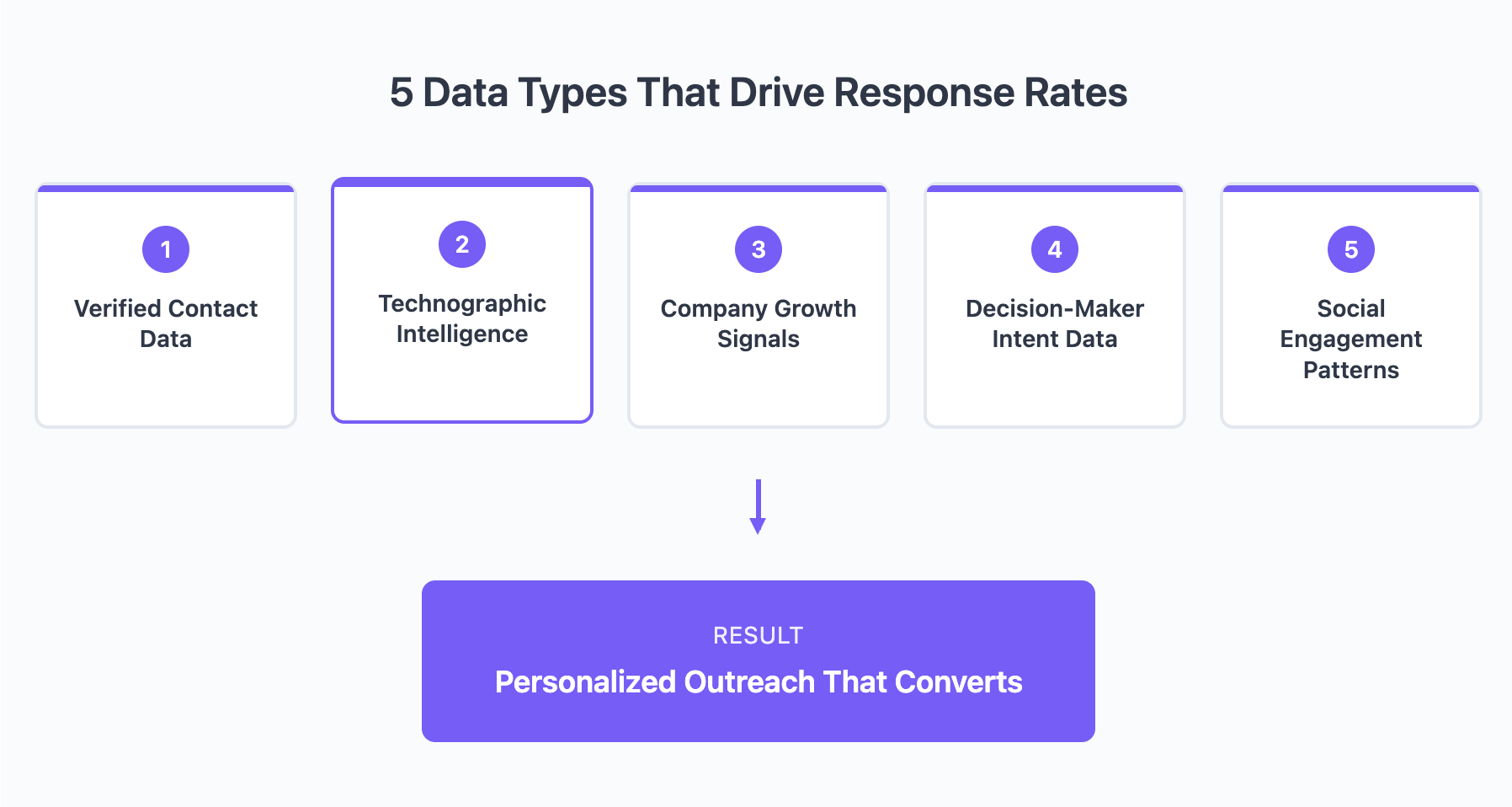
Company Growth Signals
Growth creates urgency and budget. Companies that are hiring, expanding to new markets, or launching new products have both the need and resources for new solutions.
Tracking these signals helps you reach out at the perfect moment – when your solution aligns with their immediate priorities.
Decision-Maker Intent Data
Intent data shows you who's actually in buying mode. When decision-makers consume content about your solution category, attend relevant webinars, or search for specific terms, they're signaling interest.
This data helps you prioritize outreach to prospects who are already problem-aware and solution-shopping.
Social Engagement Patterns
LinkedIn posts, comments, and shares reveal what your prospects care about right now. This real-time data provides natural conversation starters that feel organic, not forced.
When your email references something they posted about yesterday, it shows you're paying attention to their specific situation, not just blast-emailing a list.
The Waterfall Enrichment Method for 3X Better Response Rates
Here's where most teams fail: they rely on a single data source. When that source has a gap, they either skip the prospect or send a generic message.
Waterfall enrichment changes the game. Instead of accepting data gaps, you systematically check multiple sources until you find the information you need.
Start with Source A for email verification. No luck? Move to Source B. Still nothing? Try Source C. This approach typically increases data coverage from 50% to 80%+, ensuring you have complete, accurate information for nearly every prospect.
But waterfall enrichment isn't just about contact data. Apply the same principle to company information, technographics, and intent signals. The result? A complete, multi-dimensional view of every prospect that enables truly personalized outreach at scale.
Building Your Data-Driven Cold Email Strategy
Start with Multi-Source Verification
Before sending a single email, run your prospect list through multiple verification tools. This isn't just about deliverability – it's about ensuring you have the most current, accurate information.
Set up a systematic process: verify emails, cross-reference job titles with LinkedIn, confirm company information against recent news. Yes, it takes time upfront, but it saves hours of wasted effort on bad leads.
Layer in Behavioral and Intent Signals
Static data tells you who might buy. Behavioral data tells you who's ready to buy now.
Monitor for triggers like funding announcements, leadership changes, technology adoption, and content consumption patterns. When multiple signals align, you've found a prospect worth prioritizing.
Create Dynamic Personalization Fields
Move beyond basic mail merge. Create data fields for recent company news, technology gaps, growth indicators, and competitive insights.
Your email templates should have slots for genuine insights, not just names and companies. "I noticed you're expanding your engineering team by 40%" beats "I see you work at TechCorp" every time.
Real Examples: How Better Data Transforms Cold Email Performance
A B2B SaaS company selling to marketing teams increased their response rate from 2% to 11% by adding just two data points: current marketing tech stack and recent content initiatives.
Their emails shifted from "We help marketing teams succeed" to "Since you're using HubSpot but not leveraging their attribution reporting, you might find our integration valuable for tracking campaign ROI."
The difference? Specificity backed by data.
Another client in the recruiting space boosted responses from 1,5% to 8% by tracking hiring velocity. They only reached out to companies actively posting new roles, with messages tailored to the specific positions being filled.
Common Data Mistakes That Tank Response Rates
Using single-source data: Relying on one database means accepting its limitations. When that source has a 70% coverage rate, you're handicapping 30% of your outreach from the start.
Ignoring data decay: B2B data expires fast. That perfect prospect list from six months ago? It's probably 15% inaccurate already. Set up quarterly data refresh cycles to maintain quality.
Focusing only on contact data: Email addresses are just the beginning. Without context about the company, role, and current situation, even accurate contact data produces poor results.
Manual research at scale: Trying to manually research hundreds of prospects ensures inconsistent data quality and burned-out SDRs. Automation is essential for scalable success.
Your Plan to Better Data and Higher Response Rates
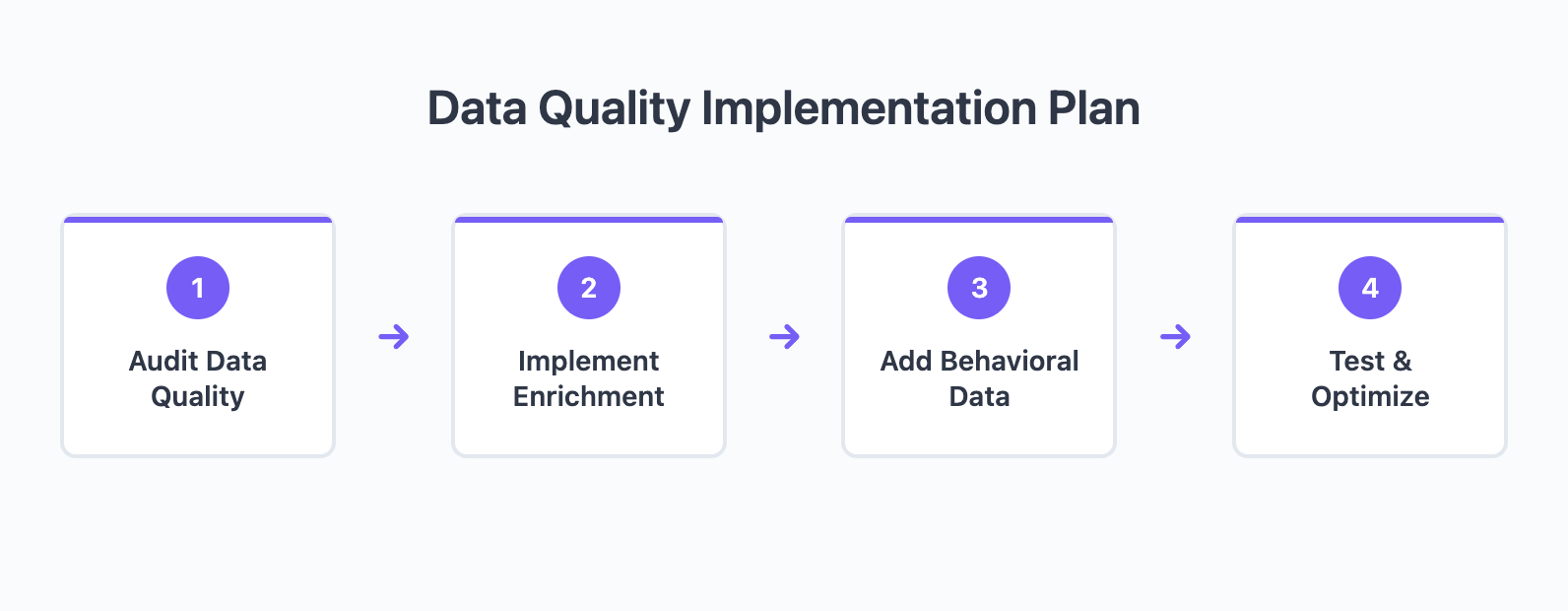
1: Audit your current data quality. Run your existing prospect lists through multiple verification tools. Calculate your bounce rate, identify data gaps, and establish a baseline.
2: Implement multi-source enrichment. Set up waterfall enrichment for contact verification, company data, and technographics. Focus on achieving 90%+ data coverage.
3: Add behavioral and intent layers. Integrate tools that track buying signals, content consumption, and social engagement. Create trigger alerts for high-priority events.
4: Test and optimize. Run A/B tests comparing emails sent with basic data versus enriched data. Track response rates, meeting bookings, and pipeline velocity.
Most teams see a 50-100% improvement in response rates within the first 30 days of implementing proper data enrichment.
Take Your Response Rates to the Next Level with Databar.ai
Perfect timing is useless if you’re emailing someone who’s no longer with the company. Thoughtful personalization loses impact when it’s based on old information. Even the catchiest subject lines won’t help if the email goes to an invalid address.
This is where Databar.ai gives you an unfair advantage and improves your data quality:
✓ 90+ data providers in one platform - Get verified emails, phone numbers, and rich prospect insights without juggling multiple subscriptions
✓ Waterfall enrichment - Automatically check multiple sources until you find the data you need, achieving 80%+ coverage rates
✓ Real-time verification - Ensure every email reaches its target with multi-source validation
✓ Behavioral triggers - Know exactly when prospects are ready to buy based on hiring patterns, funding events, and technology adoption
✓ AI-powered personalization - Generate unique, contextual email openers based on real prospect data
Ready to find new clients for your business?
Start your free Databar.ai trial today and build your first enriched prospect list in minutes. No credit card required.
FAQs About Data-Driven Cold Email Optimization
Q: Which data points have the biggest impact on response rates? A: Verified direct email addresses, current job titles, recent company initiatives, and technology stack data typically drive the biggest improvements. Intent signals and trigger events come next.
Q: How often should I refresh my prospect data? A: For active campaigns, verify and enrich data in real-time. For prospect databases, run quarterly updates at minimum. High-velocity industries like tech startups may need monthly refreshes.
Q: Can better data really improve response rates if my email copy is weak? A: Better data improves targeting and personalization, which can double or triple response rates even with average copy. Combined with strong copywriting, the results compound dramatically.
Related articles
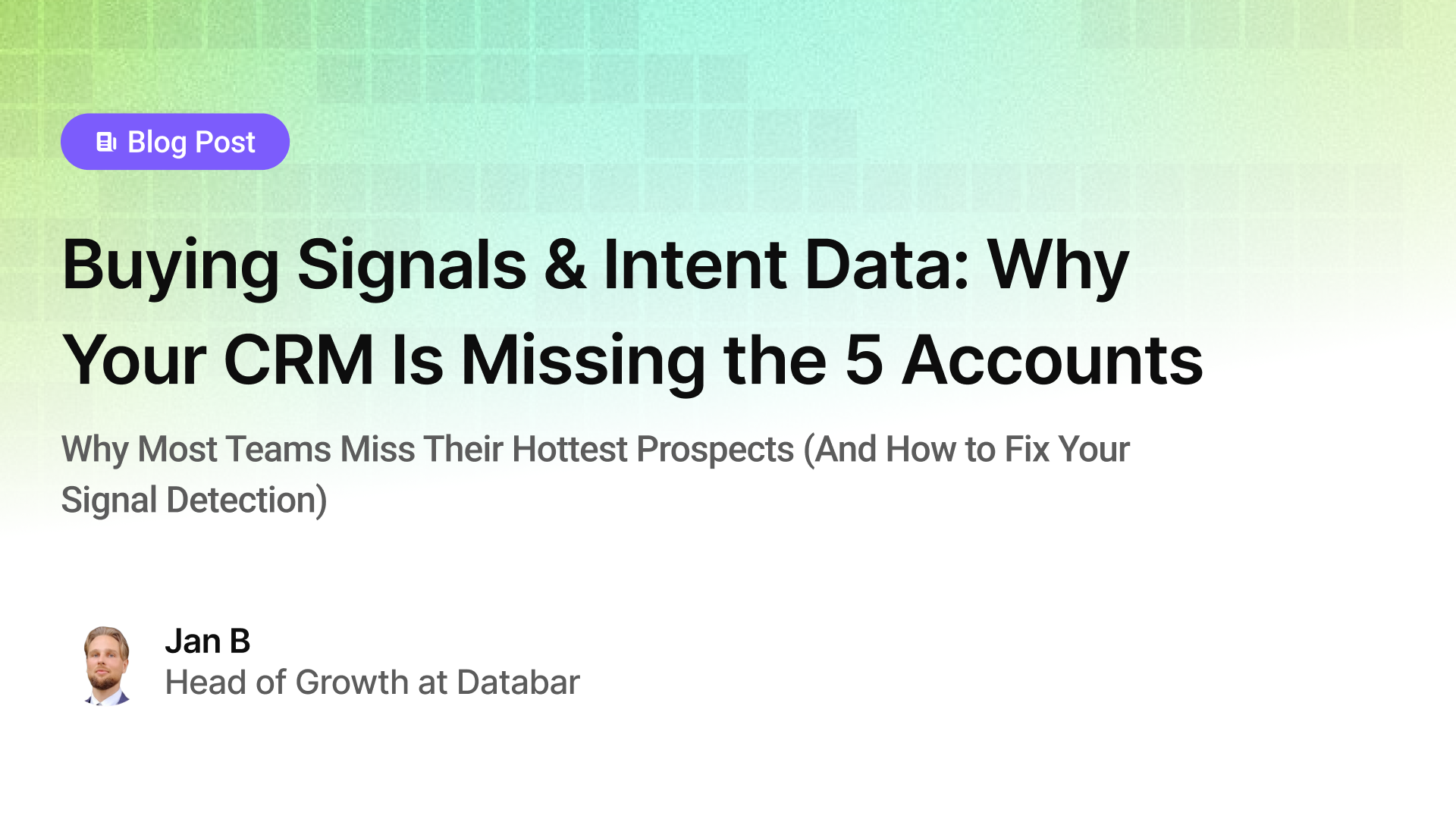
Buying Signals & Intent Data: Why Your CRM Is Missing the 5 Accounts
Why Most Teams Miss Their Hottest Prospects (And How to Fix Your Signal Detection)
by Jan, October 06, 2025

Lead Scoring & Account Segmentation: Why Most CRMs Get This Backward (And How to Fix It)
How to build a system that tells your team who to call, when, and why
by Jan, October 06, 2025
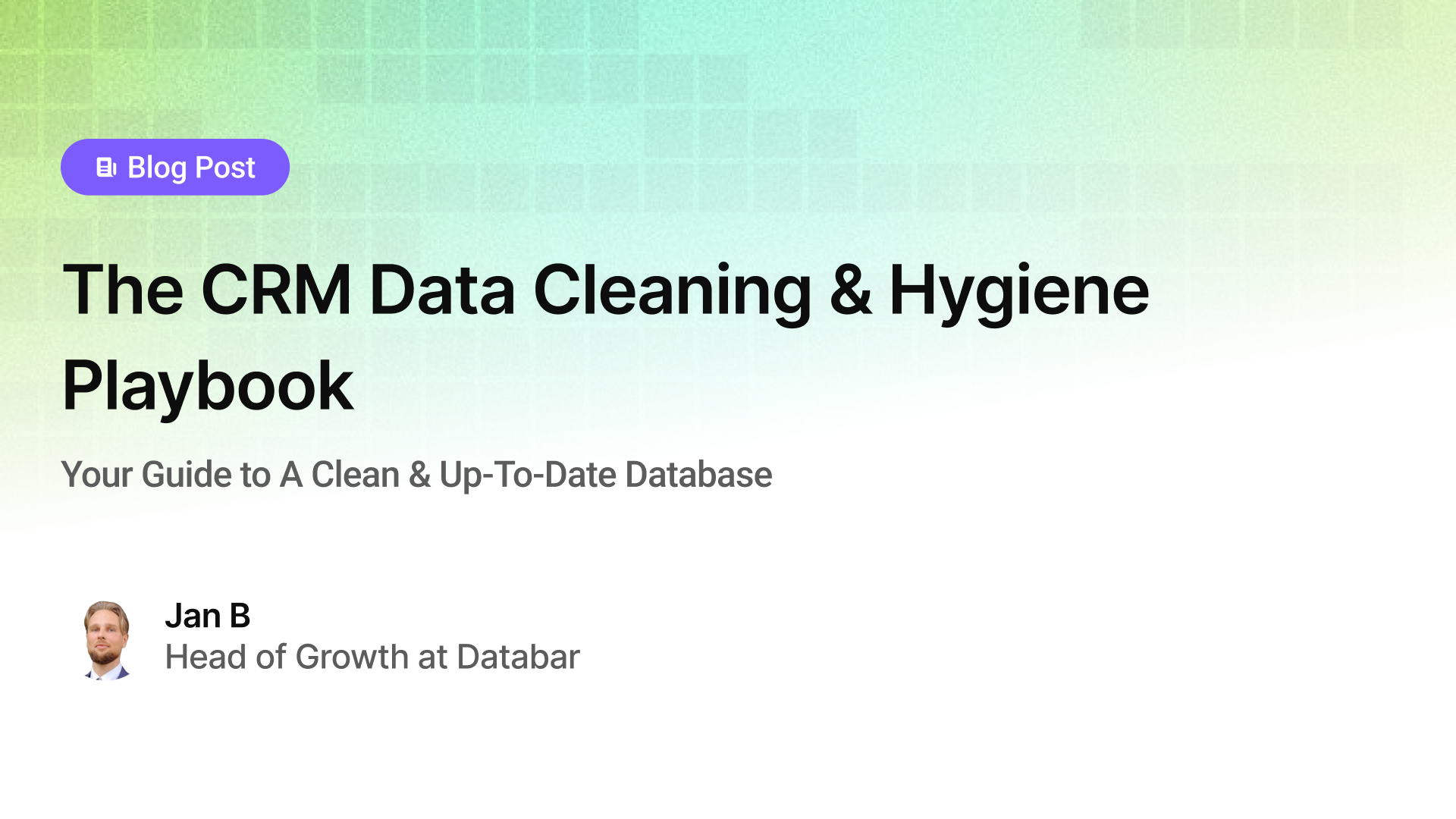
The CRM Data Cleaning & Hygiene Playbook
Your Guide to A Clean & Up-To-Date Database
by Jan, October 04, 2025
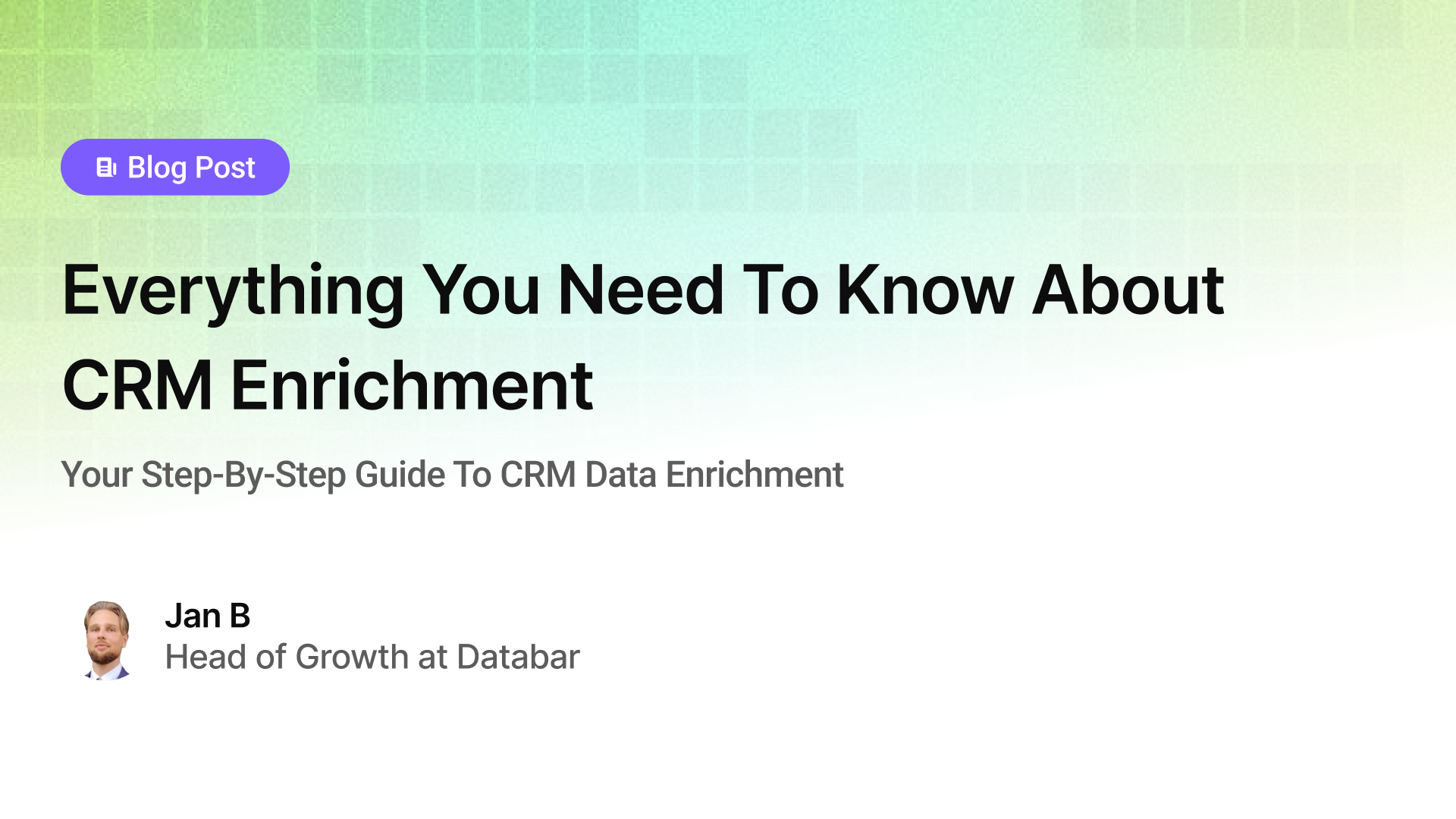
Everything You Need To Know About CRM Enrichment
Your Step-By-Step Guide To CRM Data Enrichment
by Jan, October 03, 2025